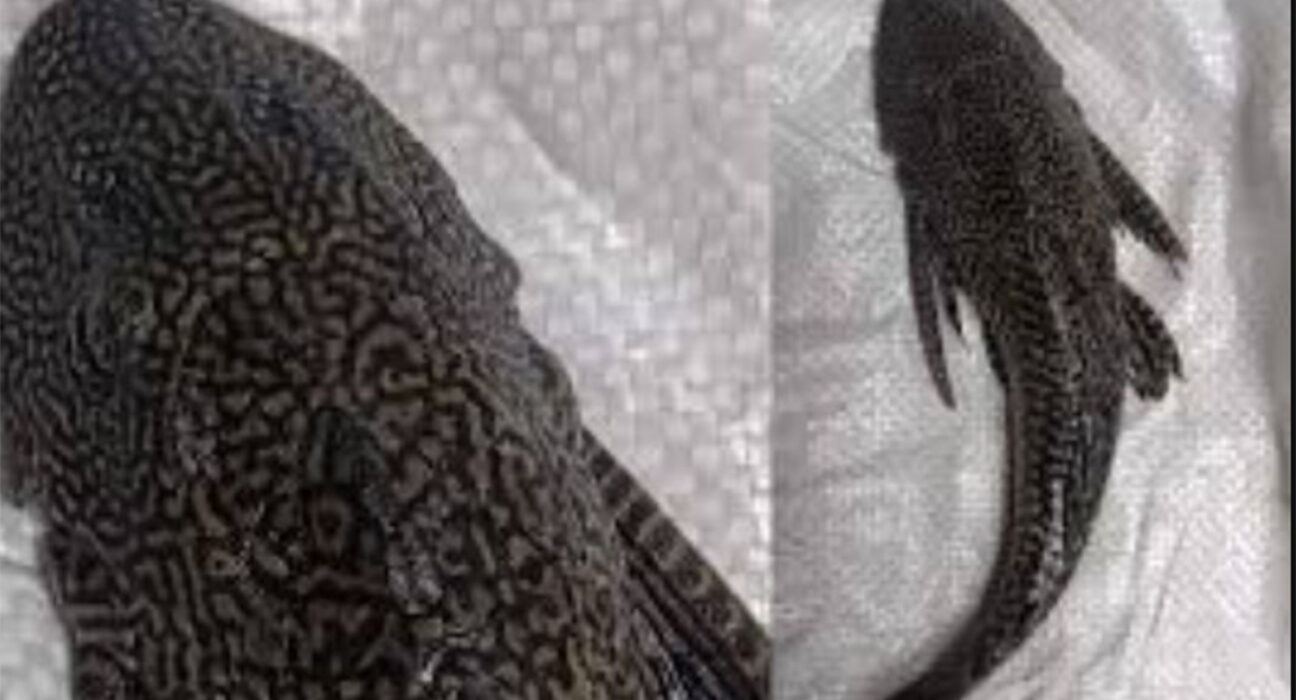Alien Catfish Found in Uttar Pradesh Sparks Panic on Ganga Banks, Scientists Raise Alarm

Varanasi, Uttar Pradesh: A rare species of catfish caught near the banks of the Ganga river in Patna village, Saidpur tehsil of Ghazipur district, has stirred panic among local fishermen and villagers. According to eyewitnesses, the fish had a shiny, spotted skin resembling a cat and was covered with thorny, armored plates all over its body. Fascinated by its unusual appearance, the locals nicknamed it the “cat-like fish.” However, when its pictures went viral on social media, experts identified it as the Suckermouth Catfish (Hypostomus plecostomus), a species native to the Amazon river basin in South America, rarely — if ever — found in Indian waters.
How Did Scientists Identify This Fish?
A team of biologists from Banaras Hindu University (BHU), led by Professor Bechan Lal, confirmed that the fish belonged to the Hypostomus plecostomus species after examining its distinct armored body and sucker-like mouth. Prof. Lal suggested that this invasive species likely entered the river system due to aquarium dumping, where non-native species are irresponsibly released into natural water bodies.
Renowned environmental scientist Kripal Dutt Joshi warned that this fish is an alien invasive species, posing a severe threat to the delicate aquatic ecosystems of rivers like the Ganga and Gomti.
“These fish are highly adaptive, with plated exteriors, voracious feeding habits, and the ability to survive in low-oxygen waters, which can outcompete native fish species and disrupt the ecological balance,” Joshi emphasized.
Previous Sightings in Eastern UP
This is not the first incident of the Suckermouth Catfish surfacing in Indian rivers. Back in 2020, a similar fish was caught near Ramnagar, Varanasi. At that time, scientists had speculated that the fish might have been released from an overgrown aquarium.
The same year, in Bhadohi district’s DhanTulsi Kala village, locals caught an unusual “four-eyed, spiked fish,” which upon examination, turned out to be another variant of the Suckermouth Catfish. The discovery had then led to an uproar in local media and social platforms. Fisheries and forest department teams had rushed to the spot and secured the fish for laboratory testing.
Why Are Experts Concerned?
The primary concern stems from the fact that this species is non-native to Indian freshwater systems. Its aggressive feeding behavior and rapid reproduction can severely impact the breeding cycles and food chains of indigenous fish species. Environmentalists fear that this could trigger an ecological imbalance in the Ganga’s biodiversity, as these catfish can latch onto aquatic plants, consume small invertebrates, and even affect fish eggs, thereby posing a multi-layered threat to the food web.
Authorities have directed fisheries officials to register the incident, monitor river ecosystems vigilantly, and ensure that the fish specimen is kept under scientific observation. Fishermen across the region — from Lucknow to Ghazipur, Bhadohi, and Varanasi — have been advised to stay alert and report any further sightings of this foreign species.
Experts have called for urgent intervention from the State Fisheries Development Department and Wildlife Boards to conduct ecological surveys, bio-monitoring programs, and community awareness campaigns to mitigate this looming threat.
Environmentalists warn that such invasive species incidents are an alarming indicator of the fragile state of India’s riverine ecosystems, necessitating swift, science-backed action.










